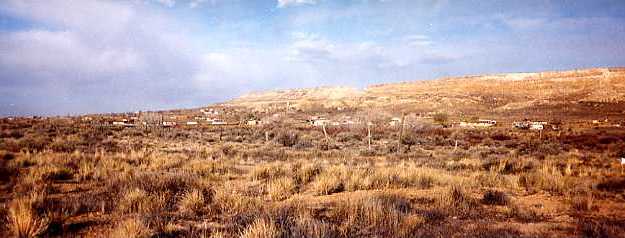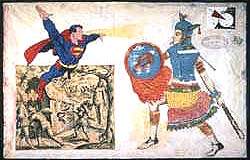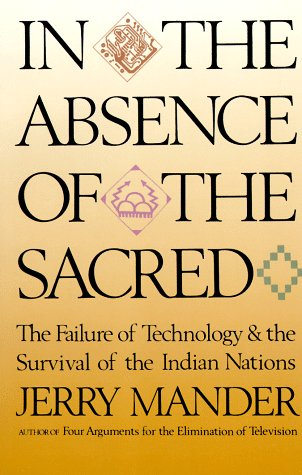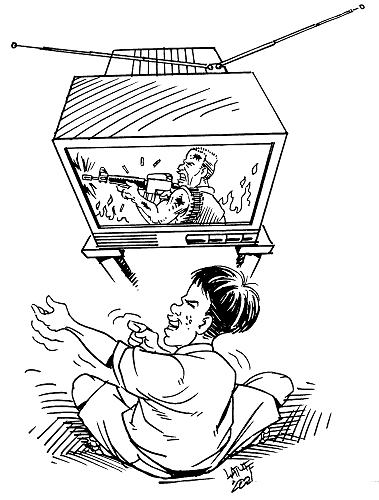 Some provocative postings that question the fundamental assumptions of our society. First, Jerry Mander questions the widely held notion that television is neutral. From Mother Earth News, September-October 1978:
Some provocative postings that question the fundamental assumptions of our society. First, Jerry Mander questions the widely held notion that television is neutral. From Mother Earth News, September-October 1978:
 Some provocative postings that question the fundamental assumptions of our society. First, Jerry Mander questions the widely held notion that television is neutral. From Mother Earth News, September-October 1978:
Some provocative postings that question the fundamental assumptions of our society. First, Jerry Mander questions the widely held notion that television is neutral. From Mother Earth News, September-October 1978:
Four Arguments for the Elimination of the Television
...[W]hat really drove me onward to investigate television was an experience I had while working with the Hopi Indians. I think it will be worth describing this experience in its full detail because its complexity is part of its point.
Television at Black Mesa
It was during the summer of 1972, just as I was closing down Freeman, Mander and Gossage, that I was asked to help some traditional Hopi elders who were fighting a strip mine on their reservation at Black Mesa, Arizona.
Black Mesa was sacred ground to the traditional Hopis. To rip it open and remove its contents was a violation of their most ancient religious tenets.
The problem at Black Mesa was typical of what has happened on many Indian reservations. The traditional Hopi Indians had always refused to deal with the Bureau of Indian Affairs, which functions as overlord on all reservations, and so they had been pushed aside. In their stead, the Bureau had created a tribal council composed mainly of Indians who no longer lived on the reservation. The tribal council members were not really even Hopis anymore; they were Mormons. Most had moved to Salt Lake City, had businesses there, and returned to the reservation only for their council meetings. They agreed with the BIA that their job was to sell off Indian resources and land at the best possible price, thereby helping Indian people turn into Americans more quickly. The sale of strip mine rights to a coal company was simply part of the logic of this process.
The traditional "government" which had preceded the tribal council was not really a government at all. It was a kind of informal grouping of religious leaders from the dozens of independent clans which together formed the Hopis. They did not sit in a hierarchical arrangement over the rest of the Hopis; they functioned more as teachers or as guides to the religious conceptions.
The religion itself was based on what we would now think of as ecological laws of balance. The land was alive, the source of life. To rip it up and ship away its contents was so outrageous as to be unthinkable. To the MormonAmerican Hopis, however, strip mines were indeed thinkable.
Eventually the traditionals realized that while they were ignoring the BIA and the tribal council, the land was being destroyed and the religion with it. The elders decided to fight. To fight they needed to learn white legal systems, white tactics, and white means of manipulating media. To learn these, they had to restructure their minds and conceptions. And so to fight the enemy, the traditional Hopis began the process of self-destroying what remained of their own Indianness.
At some point television news discovered the struggle. Network crews were flown out from Hollywood. They shot images of the deserts, images of the fifty-foot cranes, images of the older men and women standing picturesquely near their kivas. Following the network news guidelines for "good television" they sought a "balanced report." They interviewed members of the Bureau of Indian Affairs, members of the tribal council, and representatives of the coal company, all of whom discussed the issues in terms of contracts, rights, jobs and energy.
These opinions were juxtaposed with shots of some of the elderly Hopis, standing in the desert, speaking of the Great Spirit being represented in all things.
The newsmen added some footage of Hopi sacred dances and some images of the Hopi's most spiritual place, the kiva. The elders limited how far the reporters could go into their religion. It is against the Hopi religion, for example, to allow ceremonies and "power objects" to be photographed. The elders felt that to photograph these things "steals their aura." (As we will see in Argument Four, this may not be a silly notion.) They also felt that exposing their ceremonies to people who have not been trained to understand them—a process that takes Hopi apprentices many years—would undermine the meaning of the ceremonies.
A week later, I watched the report on television. It got four minutes on the evening news. It was an earnest report. The reporters revealed that their sympathies lay with the traditionals, but they had created—as they had no choice but to do—a formula story: Progress vs. Tradition. Forty million Americans obtained their first, and perhaps only, views of the Hopi people in the form of images of cranes juxtaposed with Indians in suits and ties, responsible government officials concerned about jobs, and a lot of old savage-looking types in funny clothes, talking about a religion which says that to dig up the land is dangerous for the survival of every creature on the planet. These forty million viewers also saw a white, modishly dressed TV newsman explain the crosscurrents in the struggle, and plaintively ask whether something of an earlier culture couldn't be permitted to remain. "From Black Mesa, Arizona, this is John Doe reporting." This was followed by a commercial for Pacific Gas and Electric on the growing energy crisis and the need to tap all energy resources. The next story on the news was about a bank robbery.

I turned off the television set and wondered what effect this story had had on viewers. Did it help the Hopis? Would any good come from it?
It was certain that the old people had not come through as well as the business men, the government officials and the reporter's objective, practical analysis. The old people just seemed tragic, and a little silly, if poignant. They were attempting to convey something subtle, complex, foreign and ancient through a medium which didn't seem able to handle any of that and which is better suited to objective data, conflict and fast, packaged information.
I wondered, had I been shooting that story myself for the evening news, if I could have done a better job of it. Could I have been able to explain to white America that to care about what was going on down there they would have to have cared about the Hopi perception of reality; the Hopi mind and its integration with natural forces? Viewers would have had to care about the landscape, the spaces, the time, the wind, the color, the feel of the land and the sacred places and things. How could I have conveyed something through the medium so that anyone would have cared, when everyone was sitting at home in darkened living rooms, watching television? It was time travel that needed to be conveyed. How could I have carried a viewer from home through time and space to another reality which can only make sense if experienced directly? I decided that my report would have been no better than this Hollywood crew's had been. In fact, theirs was probably as good as could have been done within the limits of the medium. But in the end, the Hopis were hurt, not helped. Their struggle was revealed, perhaps, but they themselves were further fixed into the model of artifact. The medium could not be stretched to encompass their message.
On the other hand, what if I had four minutes, or even one minute, to convey the essence of a product? A car? A stereo set? A toy? Could I accomplish that efficiently?
I certainly could. It suddenly became obvious to me that a product is a lot easier to get across on television than a desert or a cultural mindset.
Understanding Indian ways enough to care about them requires understanding a variety of dimensions of nuance and philosophy. You don't need any of that to understand a product, you do not have problems of subtlety, detail, time and space, historical context or organic form. Products are inherently communicable on television because of their static quality, sharp, clear, highly visible lines, and because they carry no informational meaning beyond what they themselves are. They contain no life at all and are therefore not capable of dimension. Nothing works better as telecommunication than images of products.
Might television itself have no higher purpose?
The Illusion of Neutral Technology
Most Americans, whether on the political left, center, or right, will argue that technology is neutral, that any technology is merely a benign instrument, a tool, and depending upon the hands into which it falls, it may be used one way or another. There is nothing that prevents a technology from being used well or badly; nothing intrinsic in the technology itself or the circumstances of its emergence which can predetermine its use, its control or its effects upon individual human lives or the social and political forms around us.
The argument goes that television is merely a window or a conduit through which any perception, any argument or reality may pass. It therefore has the potential to be enlightening to people who watch it and is potentially useful to democratic processes.
It will be the central point of this book that these assumptions about television, as about other technologies, are totally wrong.
If you once accept the principle of an army—a collection of military technologies and people to run them—all gathered together for the purpose of fighting, overpowering, killing and winning, then it is obvious that the supervisors of armies will be the sort of people who desire to fight, overpower, kill and win, and who are also good at these assignments: generals. The fact of generals, then, is predictable by the creation of armies. The kinds of generals are also predetermined. Humanistic, loving, pacifistic generals, though they may exist from time to time, are extremely rare in armies. It is useless to advocate that we have more of them.

If you accept the existence of automobiles, you also accept the existence of roads laid upon the landscape, oil to run the cars, and huge institutions to find the oil, pump it and distribute it. In addition you accept a sped-up style of life and the movement of humans through the terrain at speeds that make it impossible to pay attention to whatever is growing there. Humans who use cars sit in fixed positions for long hours following a narrow strip of gray pavement, with eyes fixed forward, engaged in the task of driving. As long as they are driving, they are living within what we might call "roadform." Slowly they evolve into car-people. McLuhan told us that cars "extended" the human feet, but he put it the wrong way. Cars replaced human feet.
If you accept nuclear power plants, you also accept a techno-scientific-industrial-military elite. Without these people in charge, you could not have nuclear power. You and I getting together with a few friends could not make use of nuclear power. We could not build such a plant, nor could we make personal use of its output, nor handle or store the radioactive waste products which remain dangerous to life for thousands of years. The wastes, in turn, determine that future societies will have to maintain a technological capacity to deal with the problem, and the military capability to protect the wastes. So the existence of the technology determines many aspects of the society.
If you accept mass production, you accept that a small number of people will supervise the daily existence of a much larger number of people. You accept that human beings will spend long hours, every day, engaged in repetitive work, while suppressing any desires for experience or activity beyond this work. The workers' behavior becomes subject to the machine. With mass production, you also accept that huge numbers of identical items will need to be efficiently distributed to huge numbers of people and that institutions such as advertising will arise to do this. One technological process cannot exist without the other, creating symbiotic relationships among technologies themselves.
If you accept the existence of advertising, you accept a system designed to persuade and to dominate minds by interfering in people's thinking patterns. You also accept that the system will be used by the sorts of people who like to influence people and are good at it. No person who did not wish to dominate others would choose to use advertising, or choosing it, succeed in it. So the basic nature of advertising and all technologies created to serve it will be consistent with this purpose, will encourage this behavior in society, and will tend to push social evolution in this direction.
In all of these instances, the basic form of the institution and the technology determines its interaction with the world, the way it will be used, the kind of people who use it, and to what ends.
And so it is with television.
Far from being "neutral," television itself predetermines who shall use it, how they will use it, what effects it will have on individual lives, and, if it continues to be widely used, what sorts of political forms will inevitably emerge.
All technology imposes values
Next, Mander expands his critique to technology in general.
Introduction: In the Absence of the Sacred
By Jerry Mander
Originally I planned to write two books. The first was to be a critique of technological society as we know it in the United States, a kind of sequel to Four Arguments for the Elimination of Television. Instead of concentrating on TV, though, it would have focused on the new technological age: "the information society," computerization, robotization, space travel, artificial intelligence, genetics, satellite communications. This seemed timely, since these technologies are changing our world at an astoundingly accelerating rate. Thus far, most people view these changes as good. But are they?
That our society would tend to view new technologies favorably is understandable. The first waves of news concerning any technical innovation are invariably positive and optimistic. That's because, in our society, the information is purveyed by those who stand to gain from our acceptance of it: corporations and their retainers in the government and scientific communities. None is motivated to report the negative sides of new technologies, so the public gets its first insights and expectations from sources that are clearly biased.

Over time, as successive generations of idealized technical innovations are introduced and presented at World's Fairs, in futurists' visions, and in hundreds of billions of dollars' worth of advertising, we develop expectations of a technological utopia here on Earth and in great domed cities in space. We begin to equate technological evolution with evolution itself, as though the two were equally inevitable, and virtually identical. The operating homilies become "Progress is good," "There's no turning back," and "Technology will free humans from disease, strife, and unremitting toil."
Debate on these subjects is inhibited by the fact that views of technology in our society are nearly identical across the political and social spectrum. The Left takes the same view of technology as do corporations, futurists, and the Right. Technology, they all say, is neutral. It has no inherent politics, no inevitable social or environmental consequences. What matters, according to this view, is who controls technology.
I have attended dozens of conferences in the last ten years on the future of technology. At every one, whether sponsored by government, industry, or environmentalists or other activists, someone will address the assembly with something like this: "There are many problems with technology and we need to acknowledge them, but the problems are not rooted to the technologies themselves. They are caused by the way we have chosen to use them. We can do better. We must do better. Machines don't cause problems, people do." This is always said as if it were an original and profound idea, when actually everyone else is saying exactly the same thing.
As we will see, the idea that technology is neutral is itself not neutral — it directly serves the interests of the people who benefit from our inability to see where the juggernaut is headed.
I only began to glimpse the problem during the 1960s when I saw how excited our society became about the presumed potentials of television. Activists, like everyone else, saw the technology opportunistically, and began to vie with other segments of society for their twenty seconds on the network news. A kind of war developed for access to this powerful new instrument that spoke pictures into the brains of the whole population, but the outcome was predetermined. We should have realized it was a foregone conclusion that TV technology would inevitably be controlled by corporations, the government, and the military. Because of the technology's geographic scale, its cost, the astounding power of its imagery, and its ability to homogenize thought, behavior, and culture, large corporations found television uniquely efficient for ingraining a way of life that served (and still serves) their interests. And in times of national crisis, the government and military find TV a perfect instrument for the centralized control of information and consciousness. Meanwhile, all other contenders for control of the medium have effectively fallen by the wayside.
Now we have the frenzy over computers, which, in theory, can empower individuals and small groups and produce a new information democracy. In fact, as we will see in Chapter 4, the issue of who benefits most from computers was already settled when they were invented. Computers, like television, are far more valuable and helpful to the military, to multinational corporations, to international banking, to governments, and to institutions of surveillance and control — all of whom use this technology on a scale and with a speed that are beyond our imaginings — than they ever will be to you and me.
Computers have made it possible to instantaneously move staggering amounts of capital, information, and equipment throughout the world, giving unprecedented power to the largest institutions on the earth. In fact, computers make these institutions possible. Meanwhile, we use our personal computers to edit our copy and hook into our information networks — and believe that makes us more powerful.
Even environmentalists have contributed to the problem by failing to effectively criticize technical evolution despite its obvious, growing, and inherent bias against nature. I fear that the ultimate direction of technology will become vividly clear to us only after we have popped out of the "information age" — which does have a kind of benevolent ring — and realize what is at stake in the last two big "wilderness intervention" battlegrounds: space and the genetic structures of living creatures. From there, it's on to the "postbiological age" of nanotechnology and robotics, whose advocates don't even pretend to care about the natural world. They think it's silly and out of date.
This first book was intended to raise questions about whether technological society has lived up to its advertising, and also to address some grave concerns about its future direction. Until now we have been impotent in the face of the juggernaut, partly because we are so unpracticed in technological criticism. We don't really know how to assess new or existing technologies. It is apparent that we need a new, more holistic language for examining technology, one that would ignore the advertised claims, best-case visions, and glamorous imagery that inundate us and systematically judge technology from alternative perspectives: social, political, economic, spiritual, ecological, biological, military. Who gains? Who loses? Do the new technologies serve planetary destruction or stability? What are their health effects? Psychological effects? How do they affect our interaction with and appreciation of nature? How do they interlock with existing technologies? What do they make possible that could not exist before? What is being lost? Where is it all going? Do we want that?
In the end, we can see that technological evolution is leading to something new: a worldwide, interlocked, monolithic, technical-political web of unprecedented negative implications.

The second book was to be a kind of continuation and update of Dee Brown's Bury My Heart at Wounded Knee. That book impressed me tremendously when I read it twenty years ago. In one sense it was a masterful work, detailing in excruciating fashion US double-dealing and brutality against the Indians. But in another sense Brown did the Indian cause a disservice by seeming to suggest that they were all wiped out, and that now there is nothing to be done. The book put the reader through an emotional catharsis; having read it, it was as if one had already paid one's dues. Combined with the popular imagery from television and films, the book helped remand Indian issues to the past.
Even liberal-minded people, concerned about issues of justice, who acknowledge the atrocities committed on this land, tend to speak of Indian issues as tragedies of the distant past. So ingrained is this position that when, occasionally, non-Indians do come forward on behalf of present-day Indian causes — Marlon Brando, William Kunstler, Robert Redford, Kevin Costner, Jane Fonda — they are all put into that "romantic" category. People are a bit embarrassed for them, as if they'd stepped over some boundary of propriety. When environmentalists such as David Brewer occasionally speak publicly about how we should heed the philosophies of the Inuit (Eskimos), they are thought impractical, uncool...not team players. (And when a specific issue pits native traditions against some current environmental concern, such as fur trapping, or subsistence sealing, or whaling, the native viewpoint is not given a fair hearing; literary luminaries like Peter Matthiessen have also been chastised for books on contemporary Indian issues (In the Spirit of Crazy Horse and Indian Country), with the implication that they should return to novels and Zen explorations.
I have had my own experiences with this. In Four Arguments I reported several encounters with Indians as a way of revealing bias in the media. I was surprised at the number of critics who cited those lines as foolish. Gene Youngblood, for example, a respected radical writer on media issues, said, "Mander is so naive.... My God, that old sixties chestnut, the Indians."
I thought that even Nelson Mandela got that treatment when he spoke about Indians at his 1990 Oakland rally. The news reports seemed to suggest that he didn't quite understand "our Indians."
The Indian issue is not part of the distant past. Many of the worst anti-Indian campaigns were undertaken scarcely 80 to 100 years ago. Your great-grandparents were already alive at the time. The Model-T Ford was on the road.
More to the point is that the assaults continue today. While the Custer period of direct military action against Indians may be over in the United States, more subtle though equally devastating "legalistic" manipulations continue to separate Indians from their land and their sovereignty, as we will see from the horrible events in Alaska, described in Chapter 16.
There are still over one and a half million Indians in the United States today. Significant numbers of them continue to live in wilderness and desert regions and in the far north of Alaska, often engaging in traditional subsistence practices on the same lands where their ancestors lived for millennia. Contrary to popular assumptions, most of these Indians are not eager to become Americans, despite the economic, cultural, and legal pressures to do so.
Elsewhere in the world, millions of native peoples also live in a traditional manner, while suffering varying degrees of impact from the expansion of Western technological society. In places such as Indonesia, Borneo, New Guinea, the Amazon forests, Bolivia, Peru, Ecuador, Guatemala, parts of central Africa, the north of Canada, and even Scandinavia, the Soviet Union, China, and Tibet, tribal peoples are struggling to defend their ancestral lands. In other places, such as India, Iraq, Turkey, Mexico, Chile, the Pacific islands, New Zealand, and Australia, millions more native peoples live a kind of in-between existence, while they are under cultural, economic, or military siege.
According to Cultural Survival, the Boston-based human rights organization, there are at least 3,000 native nations in the world today that continue to function within the boundaries of the 200-odd countries that assert sovereignty over them. Many wars that our media describe as "civil wars" or "guerrilla insurgencies" are actually attempts by tribal nations to free themselves of the domination of larger nation-states. In Guatemala, it's the Mayans. In Burma, it's the Karens. In the Amazon, it's the Yano-mamo and the Xingu, among others. In Micronesia, it's the Belauans. In Indonesia, it's the peoples of Irian Jaya.
Perhaps the most painful realization for Americans is that in many of these foreign locales — particularly South America, the Pacific islands, Indonesia, and the Philippines — the natives' struggles to maintain their lands and sovereignty is often directed against United States corporations, or technology, or military. More to the point, it is directed against a mentality, and an approach to the planet and to the human place on Earth, that native people find fatally flawed. For all the centuries they've been in contact with us, they've been saying that our outlook is missing something. But we have ignored what they say. To have heeded them would have meant stopping what we were doing and seeking another path. It is this very difference in world views that has made the assault on Indian people inevitable.

While planning to write these two books, however, it became apparent to me that their subjects were inseparable. They belonged together as one book. There is no way to understand the situation of Indians, Eskimos, Aborigines, island peoples, or other native societies without understanding the outside societies that act upon them. And there is no way to understand the outside societies without understanding their relationships to native peoples and to nature itself.
All things considered, it may be the central assumption of technological society that there is virtue in overpowering nature and native peoples. The Indian problem today, as it always has been, is directly related to the needs of technological societies to find and obtain remotely located resources, in order to fuel an incessant and intrinsic demand for growth and technological fulfillment. The process began in our country hundreds of years ago when we wanted land and gold. Today it continues because we want coal, oil, uranium, fish, and more land. As we survey the rest of the world — whether it is the Canadian Arctic, the Borneo jungle, or the Brazilian rainforest — the same interaction is taking place for the same reasons, often involving the same institutions.
All of these acts were and are made possible by one fundamental rationalization: that our society represents the ultimate expression of evolution, its final flowering. It is this attitude, and its corresponding belief that native societies represent an earlier, lower form on the evolutionary ladder, upon which we occupy the highest rung, that seem to unify all modern political perspectives: Right, Left, Capitalist, and Marxist.
Save for such nascent movements as bioregionalism and Green politics, which have at least questioned the assumptions underlying this attitude, most people in Western society are in agreement about our common superiority. So it becomes okay to humiliate — to find insignificant and thus subject to sacrifice — any way of life or way of thinking that stands in the way of a kind of "progress" we have invented, which is scarcely a century old. In fact, having assumed such superiority, it becomes more than acceptable for us to bulldoze nature and native societies. To do so actually becomes desirable, inevitable, and possibly "divine."
But the assertion that technological society is something higher than what came before, and that it is bound to bring us a better world, has lately fallen open to grave doubts. The Industrial Revolution is about a century old, and we have had ample time to draw a few conclusions about how it is going. It is not too soon to observe that this revolution may not be living up to its advertising, at least in terms of human contentment, fulfillment, health, sanity, and peace. And it is surely creating terrible and possibly catastrophic impacts on the earth. Technotopia seems already to have failed, but meanwhile it continues to lurch forward, expanding its reach and becoming more arrogant and dangerous.
The next questions become: Can we expect the situation to improve or worsen in the future? And what of the people who always told us that this way could not work, and continue to say so now? Finally, which is the more "romantic" viewpoint: that technology will fix itself and lead us to paradise, or that the answer is something simpler?
IN THE ABSENCE OF THE SACRED
The Failure of Technology and the
Survival of the Indian Nations
By Jerry Mander
Sierra Club Books, 1991, 446 pages
In his 1978 bestseller, Four Arguments for the Elimination of Television, Jerry Mander argued that television is, by its very nature, a harmful technology. The trouble with television is not a matter of content, as the current debate suggests, it goes deeper than that. Whether one watches children's programming on public television or violent, late-night crime dramas, the effects are essentially the same, Mander said: the medium itself acts a visual intoxicant, entrancing the viewer and thereby replacing other forms of knowledge with the imagery of its programmers. Television's effects on young children are especially deleterious, Mander insisted, since it infuses them with high-tech, high-speed expectations of life and separates them from their natural environments. Furthermore, television is used as a vehicle for commercialism — a commercialism predicated on the need to sell viewers back the very feelings their entrancement has eclipsed. We cannot hope to understand television, Mander concluded, without looking at the totality of its effects.

In the Absence of the Sacred takes this argument a step further by examining our relationship to technology as a whole. It's a tremendously forceful critique that has permanently changed the way I think about technology and its role in our lives.
Mander takes issue with the widespread notion that technology is neutral and that only people determine whether its effects are good or bad. "This idea would be merely preposterous if it were not so widely accepted, and so dangerous," he writes. Because technologies contain certain inherent qualities, they are not neutral. In the case of nuclear energy, for example, it doesn't matter who is in charge because the dangers inherent in the process are the same: the long-term effects of waste, the safety hazards, the lack of local controls, etc.
The belief that technology is neutral is only one aspect of what Mander calls "the pro-technology paradigm" — "a system of perceptions that make us blind and passive when it comes to technology." It's a cultural mindset that has emerged over time as we've become more and more accustomed to living with technology. It's also a product of the optimistic, even utopian, claims that invariably accompany the introduction of new technology. Another factor contributing to our passivity in the face of technology, Mander contends, is the habit of evaluating it in strictly personal terms. By stressing the benefits of technology in our personal lives — the machine vacuums our carpets, the television keeps us informed, the car gets us around, the computer allows us to work from home, etc. — we make little attempt to understand its larger societal and ecological consequences.
What we need, in Mander's view, is a society-wide debate about the costs of technology — economically, socially, environmentally, and in terms of public health. "In a truly democratic society," he writes "any new technology would be subject to exhaustive debate. That a society must retain the option of declining a technology — if it deems it harmful — is basic. As it is now, our spectrum of choice is limited to mere acceptance. The real decisions about technological introduction are made only by one segment of society: the corporate, based strictly on considerations of profit."
Mander sees a close connection between the advances of modern technological society and the plight of indigenous peoples around the world. Since the dawn of the technological era, he says, the only consistent opposition has come from land-based native peoples. Rooted in an alternative view of the planet, Indians, islanders, and peoples of the North have not only warned of the dangers of technology, they have also been its most direct victims. Mander illustrates this point with numerous examples, from Hopi-Navajo territory, where the government is forcing people off their ancestral land to make room for coal strip-mining; to Hawaii, where Native Hawaiians are struggling to save their sacred Pele, the islands, from geothermal drilling and destruction caused by bombing by NATO ships; to Death Valley, where the Western Shoshone fight for a reservation even though they never ceded any of their land to the United States, where they struggle against military pressure to keep nuclear missiles from being placed near their homes; and to the Great Plains, where the Lakota people refuse to accept a $300 million federal offer for the Black Hills. "That technological society should ignore and suppress native voices is understandable, since to heed them would suggest we must fundamentally change our way of life. Instead, we say they must change. They decline to do so."
According to Mander, we are in the midst of "an epic worldwide struggle" between the forces of Western economic development and the remaining native peoples of the planet, whose presence obstructs their progress. The ultimate outcome of this conflict is not hard to predict given that the technological juggernaut inevitably chews up the societies that warn that this path will not work. "Worst of all," Mander concludes, "these are the very people who are best equipped to help us out of our fix, if only we'd let them be and listen to what they say."
Excerpt:
Our assumption of superiority does not come to us by accident. We have been trained in it. It is soaked into the fabric of every Western religion, economic system, and technology. Judeo-Christian religions are a model of hierarchical structure: one God above all, certain humans above other humans, and humans over nature. Political and economic systems are similarly arranged: organized along rigid hierarchical lines, all of nature's resources [including 'other humans'] are regarded only in terms of how they serve the one god — the god of growth and expansion. In this way, all of these systems are *missionary*; they embrace dominance. They are the creators and the enforcers of our beliefs. We live inside these forms, we are imbued with them and they justify our behaviors. In our turn, we believe in their viability and superiority [as systems] largely because they prove effective: they gain [us] power.

Rob's comment
Wow. Forget the (sadly out-of-print) book; this posting has changed my perceptions of technology. Powerful stuff.
Not to compare my comic book to this great analysis, but this is what PEACE PARTY is all about. Questioning our basic assumptions, whether it's reshaping the world with bioengineering and nanotechnology or imposing our will with "smart bombs" and superheroic violence. Seeing the world with something other than the dominant Western mindset. In short, the multicultural perspective.
For more on the harmful effects of television and other media, see The Evidence Against Media Violence.
A couple of small corrections. The Western Shoshone are fighting for their land in Nevada, not Death Valley, California. The Timbisha Shoshone live in Death Valley and are involved in a much smaller-scale fight for land. And although corporations and the US government may want the coal on Black Mesa (Hopi-Navajo territory), the Hopi Tribe is seeking sovereignty over its sacred land.
More on technology vs. Native values
Indians vs. progress
More on globalization
Globalization: exporting the American way
Globalization according to Gilligan
Related links
Superman vs. the Mexica
Native vs. non-Native Americans: a summary
America's cultural mindset
|
. . . |

|
All material © copyright its original owners, except where noted.
Original text and pictures © copyright 2007 by Robert Schmidt.
Copyrighted material is posted under the Fair Use provision of the Copyright Act,
which allows copying for nonprofit educational uses including criticism and commentary.
Comments sent to the publisher become the property of Blue Corn Comics
and may be used in other postings without permission.